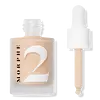What's inside
What's inside
 Key Ingredients
Key Ingredients

 Benefits
Benefits

 Concerns
Concerns

 Ingredients Side-by-side
Ingredients Side-by-side

Water
Skin ConditioningIsododecane
EmollientGlycerin
HumectantPhenyl Trimethicone
Skin ConditioningTrisiloxane
Skin ConditioningCetyl PEG/PPG-10/1 Dimethicone
EmulsifyingDimethicone
EmollientPEG-10 Dimethicone
Skin ConditioningButylene Glycol
HumectantSodium Chloride
MaskingPhenoxyethanol
PreservativeDimethiconol
EmollientMethicone
EmollientPotassium Sorbate
PreservativeSodium Dehydroacetate
PreservativeTalc
AbrasiveHydrogen Dimethicone
CI 77891
Cosmetic ColorantIron Oxides
Butyl Methoxydibenzoylmethane 2.5%
UV AbsorberEthylhexyl Methoxycinnamate 7.49%
UV AbsorberOctocrylene 2%
UV AbsorberBenzophenone-3 1%
UV AbsorberWater
Skin ConditioningGlycerin
HumectantButylene Glycol
HumectantDimethicone
EmollientPEG/PPG-14/7 Dimethyl Ether
Skin ConditioningHydrogenated Polydecene
EmollientPEG-5 Glyceryl Stearate
EmulsifyingIsododecane
EmollientSilica
AbrasivePhenyl Trimethicone
Skin ConditioningTrehalose
HumectantPhenoxyethanol
PreservativeTocopherol
AntioxidantButyrospermum Parkii Butter
Skin ConditioningMacadamia Ternifolia Seed Oil
EmollientAleurites Moluccanus Seed Oil
Skin ConditioningRhus Verniciflua Peel Wax
Tamarindus Indica Seed Gum
Emulsion StabilisingSaccharide Isomerate
HumectantPentylene Glycol
Skin ConditioningIsostearic Acid
CleansingGlyceryl Stearate Se
EmulsifyingPolysilicone-11
Behenyl Alcohol
EmollientBehenic Acid
CleansingStearic Acid
CleansingBatyl Alcohol
EmollientHydroxypropyl Methylcellulose Stearoxy Ether
PEG-30 Phytosterol
EmulsifyingDisodium EDTA
Sodium Metaphosphate
BufferingCarbomer
Emulsion StabilisingPolyacrylate Crosspolymer-6
Emulsion StabilisingPotassium Hydroxide
BufferingBHT
AntioxidantSodium Citrate
BufferingCitric Acid
BufferingT-Butyl Alcohol
PerfumingTitanium Dioxide
Cosmetic ColorantIron Oxides
Butyl Methoxydibenzoylmethane 2.5%, Ethylhexyl Methoxycinnamate 7.49%, Octocrylene 2%, Benzophenone-3 1%, Water, Glycerin, Butylene Glycol, Dimethicone, PEG/PPG-14/7 Dimethyl Ether, Hydrogenated Polydecene, PEG-5 Glyceryl Stearate, Isododecane, Silica, Phenyl Trimethicone, Trehalose, Phenoxyethanol, Tocopherol, Butyrospermum Parkii Butter, Macadamia Ternifolia Seed Oil, Aleurites Moluccanus Seed Oil, Rhus Verniciflua Peel Wax, Tamarindus Indica Seed Gum, Saccharide Isomerate, Pentylene Glycol, Isostearic Acid, Glyceryl Stearate Se, Polysilicone-11, Behenyl Alcohol, Behenic Acid, Stearic Acid, Batyl Alcohol, Hydroxypropyl Methylcellulose Stearoxy Ether, PEG-30 Phytosterol, Disodium EDTA, Sodium Metaphosphate, Carbomer, Polyacrylate Crosspolymer-6, Potassium Hydroxide, BHT, Sodium Citrate, Citric Acid, T-Butyl Alcohol, Titanium Dioxide, Iron Oxides
 Reviews
Reviews

Ingredients Explained
These ingredients are found in both products.
Ingredients higher up in an ingredient list are typically present in a larger amount.
Butylene Glycol (or BG) is used within cosmetic products for a few different reasons:
Overall, Butylene Glycol is a safe and well-rounded ingredient that works well with other ingredients.
Though this ingredient works well with most skin types, some people with sensitive skin may experience a reaction such as allergic rashes, closed comedones, or itchiness.
Learn more about Butylene GlycolDimethicone is a type of synthetic silicone created from natural materials such as quartz.
What it does:
Dimethicone comes in different viscosities:
Depending on the viscosity, dimethicone has different properties.
Ingredients lists don't always show which type is used, so we recommend reaching out to the brand if you have questions about the viscosity.
This ingredient is unlikely to cause irritation because it does not get absorbed into skin. However, people with silicone allergies should be careful about using this ingredient.
Note: Dimethicone may contribute to pilling. This is because it is not oil or water soluble, so pilling may occur when layered with products. When mixed with heavy oils in a formula, the outcome is also quite greasy.
Learn more about DimethiconeGlycerin is already naturally found in your skin. It helps moisturize and protect your skin.
A study from 2016 found glycerin to be more effective as a humectant than AHAs and hyaluronic acid.
As a humectant, it helps the skin stay hydrated by pulling moisture to your skin. The low molecular weight of glycerin allows it to pull moisture into the deeper layers of your skin.
Hydrated skin improves your skin barrier; Your skin barrier helps protect against irritants and bacteria.
Glycerin has also been found to have antimicrobial and antiviral properties. Due to these properties, glycerin is often used in wound and burn treatments.
In cosmetics, glycerin is usually derived from plants such as soybean or palm. However, it can also be sourced from animals, such as tallow or animal fat.
This ingredient is organic, colorless, odorless, and non-toxic.
Glycerin is the name for this ingredient in American English. British English uses Glycerol/Glycerine.
Learn more about GlycerinIsododecane is a fragrance, emollient, and solvent.
As an emollient, it helps your skin stay soft and hydrated. Emollients help trap moisture into your skin.
Isododecane's role as a solvent makes it a great texture enhancer. It spreads smoothly on skin and does not leave a sticky feeling behind. Isododecane also helps prevent color transfer in makeup products.
Isododecane is not absorbed into skin.
Learn more about IsododecanePhenoxyethanol is a preservative that has germicide, antimicrobial, and aromatic properties. Studies show that phenoxyethanol can prevent microbial growth. By itself, it has a scent that is similar to that of a rose.
It's often used in formulations along with Caprylyl Glycol to preserve the shelf life of products.
Phenyl Trimethicone is a silicon-based polymer. It is derived from silica.
Phenyl Trimethicone is used as an emollient and prevents products from foaming.
As an emollient, it helps trap moisture in the skin. It is considered an occlusive.
Learn more about Phenyl TrimethiconeWater. It's the most common cosmetic ingredient of all. You'll usually see it at the top of ingredient lists, meaning that it makes up the largest part of the product.
So why is it so popular? Water most often acts as a solvent - this means that it helps dissolve other ingredients into the formulation.
You'll also recognize water as that liquid we all need to stay alive. If you see this, drink a glass of water. Stay hydrated!
Learn more about WaterThis ingredient is a combination of red, black, and yellow iron oxide pigments. This combination of colors is usually found in foundation, because it results in a "skin" color.